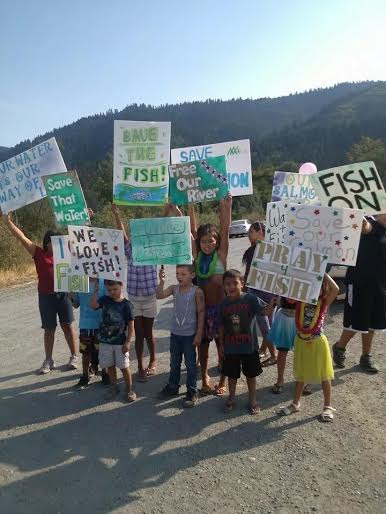Dec 27, 2015 - Will tribes hinder FERC process for Klamath dam removal? by Kayla Godowa-Tufti
FOR IMMEDIATE RELEASE – Will tribes hinder FERC process for Klamath dam removal?
Klamath River Basin, December 30th 2015- Members of the Klamath Basin attended a public meeting of the Klamath Basin Coordinating Council (KBCC) conference call on the status of the Klamath Basin Restoration Agreement (KBRA) on Monday December 28th 2015.
The KBCC parties were fairly terse on the call. The federal and state representatives said nothing at all. Humboldt County Supervisors expressed disappointment.
Klamath, Karuk, and Yurok Tribes did not withdraw their dispute notices so the KBRA will terminate on December 31st 2015 at the stroke of midnight.
Surely some of the KBRA parties will continue to push legislation. The Yurok Tribe seems to have abandoned the process and recently withdrew from the agreement but remain a signatory party.
While the KBRA terminates on Thursday, the other two agreements Klamath Hydroelectric Settlement Act (KHSA) and the Upper Klamath Basin Comprehensive Agreement (UKBCA) do not terminate.
For over a decade one of the main points of contention has been dam removal on the river. In the KBRA, signatory parties wanted California rate and taxpayers to cover the cost of dam removal for Pacificorp, the owner of the hydroelectric dams in the Klamath basin.
The Klamath Hydroelectric Settlement Agreement (KHSA), provided a planning process under which JC Boyle, Copco 1, Copco 2, and Iron Gate dams might be removed beginning in 2020. The KHSA was conditioned upon enactment of federal legislation, among other factors. That legislation clearly will not occur.
Even though, the Klamath Agreements were never a viable solution, instead of pointing fingers over its failure, elected leaders should prioritize the agreement to remove the four lower Klamath River dams.
Removal of the dams would reopen important salmon spawning habitat and improve water quality.
Will tribes take the first step toward achieving dam removal and terminate the agreement that has held up dam removal?
There’s a process under sec. 8.11 of the KHSA for termination of the agreement.
The KHSA halts the water quality certification process. And completion of that process, the “401 certification” is the only thing that prevents FERC from issuing a license that will require volitional fish passage through the dam sites.
Termination of the agreement will remove the obstacle to Federal Energy Regulatory Commission (FERC) action, which is also the objective of Hoopa’s and Yurok’s pending appeal.
The KHSA signatories should now realize that PacifiCorp deceived them by convincing them to sign an agreement under which dams come out only if Congress so directs. Those parties (other than PacifiCorp) didn’t know that Congress would never direct dam removal.
In fact, Congressional action never was and still isn’t necessary for dam removal through the FERC process.
However, the owner of the dams, PacifiCorp, could make this deal happen without Congress by asking the Federal Energy Regulatory Commission for permission to remove the dams.
PacifiCorp took similar action to remove Condit Dam, and funds for the Klamath removals have already been largely secured through a PacifiCorp customer surcharge and California state bond money.
The KHSA allows amendment in § 8.4. and § 8.11.3.D. The KHSA signatories―Karuk, Klamath and Yurok Tribes voice their concerns about water quality and dam removal in the Lower Klamath Basin.
Leaving many to wonder will tribes terminate the Klamath Hydroelectric Settlement Agreement that has been stalling the dam removal process? Or will it turn into another wasted media spectacle to delay dam removal?
For far too long the Klamath Agreements have stalled the FERC process that would ultimately determine that the dams are out of compliance and must come down regardless.
Tribal elected officials must find a way to genuinely resolve these issues not just for one particular tribe, family or person but for the future of all Indigenous children in the entire Klamath basin.
The survivance of our cultures and spirituality are directly inter related to the condition of our environment. We are an earth based people. And when the earth and our waters suffer, we too suffer.
We can no longer afford to wait for the Klamath Agreements to be some kind of miracle remedy to these issues. The longer we continue to pursue this exhausted path, the water quality continues to decline and our baby fish continue to die.
“[We want to] have a future for the tribal people, including the Hoopa tribal people, that exists and does exist because of the fish in the water in our communities,” Mike Orcutt, Fisheries Department Director for the tribe, said. “That’s the hope, a sustainable future for us all.”
A special thanks to the Hoopa Valley Tribe for their tireless commitment to defend their water rights for the well-being of the entire Klamath Basin.
Help support an effort that will truly “Undam the Klamath and bring the salmon home.”
In collaboration with and in honor of our friends at the Hoopa Valley Tribe and our Klamath, Modoc, Yahooskin relatives at Honor the Treaty of 1864.
Naat ciiwapk diceew’a “We help each other; We will live good.”
Klamath basin youth fight for access to traditional foods, Salmon
2002 Klamath River Fish Kill (AP media file)
————————————————————————————————-
Vivienna Orcutt is a Student at Humboldt State University and a Trinity River Water Advocate. She is a Descendant of the Karuk, Yurok and Hupa People whom fishing has been the center of their culture, religion and economy in the Klamath Basin for 10,000 years.
Kayla Godowa-Tufti is a member of the Confederated Tribes of Warm Springs of Oregon and a descendant of the Klamath, Modoc, Yahooskin peoples of the Upper Klamath Basin. An Indigenous rights/water advocate and freelance journalist residing in Kalapuya Territory, Oregon.

